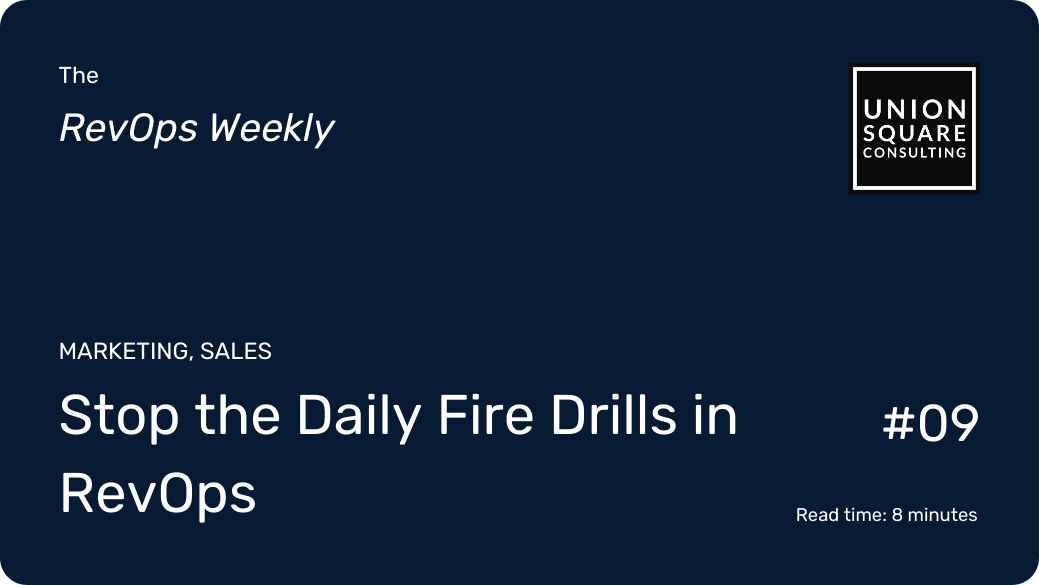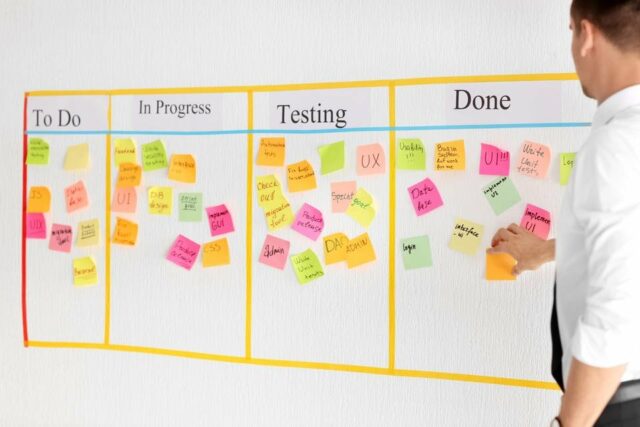
Stop the Fire Drills in RevOps
Read time: 8 minutesYou’re always putting out fires and your Revenue Operations team has become more like a customer service desk without a clear plan. You know you need a plan, but you’re too busy to make one. What can you do?
Let’s talk about why a plan, or Roadmap, is important. It helps you say “no” to things by giving you a list of projects in order of importance. You and your team will always know what to work on next, making you more efficient. It also helps you get approval for things like budgeting ahead of time. It’s a way for everyone to understand your goals.
To find time to make a plan, let’s make a system for dealing with all the requests you get. One way to do this is by using some ideas from DevOps and Lean Operations called “Kanban” and “Scrum.” These will help you triage, be transparent, and prioritize all the requests you get.
Intake System
The first step to regaining your sanity is to set up an Intake System. It’s very difficult to get work done, especially strategic work when you’re flooded with emails, Slacks, phone calls, and random meetings thrown on your calendar all day every day. An Intake System is simply a single place for these requests to go.
At Union Square Consulting, we create an Asana Project for each of our customers. Many others use Salesforce Cases and we might as well if we only had one company to serve. You could even keep it as simple as having a single email address. The most important thing is to have a single place for all requests to go.
Set Expectations
Creating an Intake System doesn’t immediately prevent people from feeling like they have a fire that needs to be put out now. So, you need to align with your stakeholders on their expectations for a response. You need an SLA, or Service Level Agreement that outlines when and how you will respond to requests. Ultimately you need a plan to process these requests so you can focus on actually getting things done.
Kanban
Kanban is a way to manage projects that helps you prioritize and see your tasks in a continuous-flow process. It was developed a long time ago at Toyota and has been proven to make things run smoother and better over time. RevOps, which is always getting requests to put out fires, is a good fit for this system. You can also think of the whole customer journey as a flow, so Kanban works well for that too.
Kanban Board
One thing we can use from Kanban is called a “Kanban board”. It can be on a whiteboard or on a computer. You break down your work into different parts and place them in columns on the board, from left to right.
Some common parts of a project are:
- Not Ready
- Waiting for someone else or a task is unclear
- Backlog/Ready
- In Progress
- Testing
- Done
You can change the column names to fit your business.

Once you have your board set up, you write down each task on a sticky note (or something similar on the computer). Make sure each task is small enough to finish in one day. The goal is for your team to work on one or two tasks at a time until they are “Done”, then pick the next most important task from the “Backlog/Ready” column. As the leader, it’s your job to gather information and move tasks from “Not Ready” to “Backlog/Ready”, and to decide what is most important. You also need to help your team by getting rid of anything that’s stopping them from finishing their work.
A Shift In Thinking
When you organize your tasks this way, the biggest change you’ll see is that your to-do list will be split into two groups: Ready and Not Ready. Tasks that you need help from your boss or another department to finish can’t be worked on. How many of the fires you put out every day are because you’re waiting for someone else? How often do you start working on something and have to stop because someone else hasn’t finished their part? Instead of only doing part of a lot of things, choose the tasks you can finish completely and do them first.
Visibility
The final benefit of the Kanban board is visibility. If your boss can see your board they know what you and your team are working on. They will know what we are waiting for more information on, and what your future priorities will be. It’s even better if you can get them involved in the “Not Ready” pile and prioritize the queue.
Think of this as a more granular, more detailed short-term view of the RevOps Roadmap that outlines longer-term priorities.
Provide access to view your board to other departments. That way everyone else will know what the status of their request is – and they’ll stop bugging you for updates!! They’ll also know what tasks are a higher priority than theirs, which is important. Depending on if you are using a digital tool (JIRA or Asana works great for this) you can create a digital Kanban board that sends alerts to people as their request is processed.
Once that’s done, just stay consistent and don’t stray from the board – “if it’s not on the board it doesn’t exist” – should be your mantra. Funnel everyone to your intake system, be it an inbox, a ticketing system, or otherwise. Stick to your guns and don’t step outside of the process to appease certain people.
Scrum
The second methodology that I’d like to steal from is Scrum. Scrum is a way of organizing product and software development teams. It is an agile framework with key roles and techniques that do a really great job of generating consistent output despite rapidly changing priorities. Sound like RevOps?
The Daily Standup
The tactic I’d suggest we lift from Scrum is the daily standup. I further suggest that this becomes the only standing team meeting on your calendar. So, cancel all the others. Every day, as early in the morning as your team’s schedule allows, have everyone meet up for a maximum of 15 minutes.
Here is your standing agenda.
Start the meeting by calling on the first person and have them answer the following
- What did you accomplish yesterday?
- What will you accomplish today?
- Do you have any blockers?
- Then have them call on the person to go next.
Pointers:
- Don’t just read out people’s calendars
- It’s very easy to devolve into this.
- While that can spur interesting conversations it’s not the aim of this call.
- Use a Parking Lot
- Often, this will lead two people to start going down a rabbit hole and bore the rest of the squad
- Try to pull people back to the topic and suggest they take things like that offline
- One person speaks at a time
- If in person, toss a ball around to see who goes next
- Focus on results, not an activity
- John Wooden once said “don’t confuse activity for achievement”
- He was right, getting work done is what matters
- Use your Kanban board as you speak
- Reprioritize as you go
- Celebrate victories
- Ring a bell, start a slow clap, sing a song, or whatever
- Make sure people know you appreciate them
After that is done, it’s ok to talk about your weekends, that movie you saw, and the game last night, but don’t let the meeting ever go long.
Once these are part of your operations, you’ll be able to see some results and you’ll be able to tackle a surprising amount of work quickly. I would suggest you also keep all of the DONE tickets somewhere and report them to your manager.
SUMMARY
- Create an Intake System
- One place for all requests to go
- Set Expectations
- Align with your team on when and how you’ll respond to requests
- Use Kanban
- Use Kanban to organize your tasks
- Provide Visibility
- Share the Kanban board with your team
- Now they can see what’s done/not done
- And stop interrupting you for updates!
- Hold a Daily Standup
- Meet your team every day for a max of 15 mins
- This is a very quick and efficient way to get aligned
If you start organizing your team this way, you’ll start to be able to free up bandwidth for yourself and your roadmap. Use the RevOps Efficiency Pyramid and start inserting projects from it into the backlog and your RevOps Roadmap. You’ll be amazed at how efficient your team can become.
When you’re ready, here’s how we can help:
Get a Free 1:1 Revenue Efficiency Workshop
Get one of our Senior Revenue Strategists to yourself for 1 hour and leave with a plan to increase the money-making power of your go-to-market operations.
Hire Us!
Bring us on as your Strategic RevOps Team and realize the growth potential of your revenue engine. There are 3 ways to work with us.
Get more tips like these, sent right to your inbox.
Subscribe for fresh, relevant revenue growth tips delivered every week.